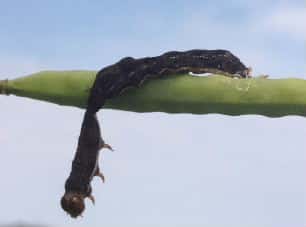
Canola growers sprayed in-crop this year for a wide range of insects, including the usual suspects — flea beetles, cutworms, diamondback moth, lygus, bertha armyworm — and also, in a few rare cases, zebra caterpillars and leaf rollers. We don’t exactly know why insects were more plentiful this year, but a mild winter and more canola than ever are likely factors.
Management for 2013: Achieving a plant stand in the range of 7 to 14 plants per square foot provides a buffer for some plant loss to insects.
Know your insects. For example, lygus at economic levels is fairly new to Saskatchewan, and growers and retailers may have underestimated the level of damage. Scouting for lygus requires a sweep net, and feeding damage tends to be small punctures and shriveled seed inside pods — which are not obvious without close inspection.
Scouting is also key to reduce cutworm damage. If you notice a bare patch, don’t write it off as simply poor emergence in a wet spot or dry knoll.
Thresholds are the point where a spray will cover its costs. To get an economic return, insect counts have to be above thresholds. By spraying below thresholds, growers don’t cover the cost of the applied product, and they put beneficial insects at risk. Diamondback moth larvae were feeding earlier than usual in 2012, but we didn’t hear much about them as the season progressed. We know that in past years when they came in early, parasitoids did a good job of reducing the population. That may have happened again in 2012.
Bertha beneficials. In the case of bertha armyworm, the leading beneficials can in some years be a fungal or viral disease. Insecticide spray is not stopping these diseases, but spraying berthas at below thresholds impedes spread of the disease through the bertha population. The diseases can provide bertha control on our behalf, and are typically what bring an end to an outbreak cycle.